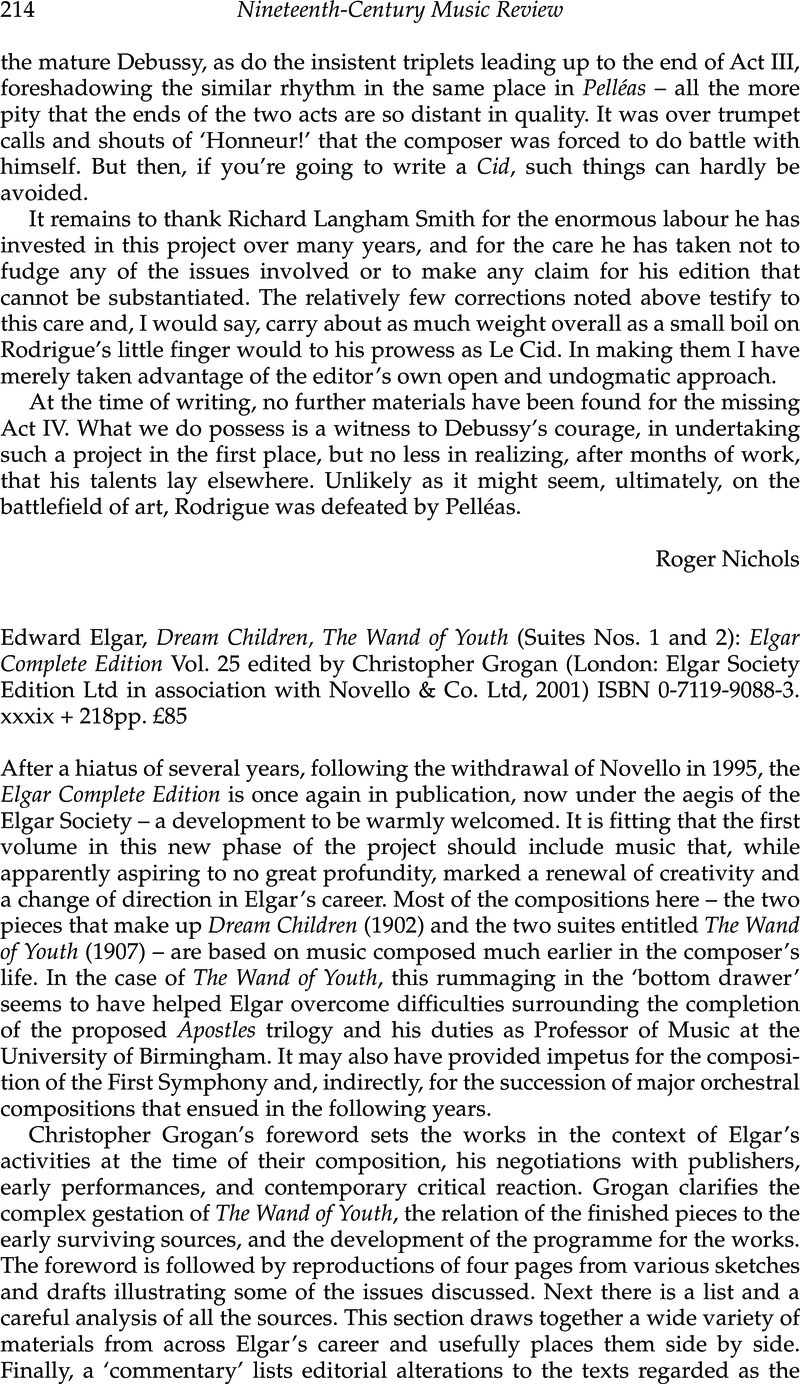No CrossRef data available.
Published online by Cambridge University Press: 13 April 2011

1 ‘And while I stood gazing, both the children gradually grew fainter to my view, receding, and still receding till nothing at last but two mournful features were seen in the uttermost distance, which, without speech, strangely impressed upon me the effects of speech: “We are not of Alice, nor of thee, nor are we children at all. We are nothing; less than nothing, and dreams. We are only what might have been.”’ From Lamb, Charles, Dream Children: A Reverie, cited in Dream Children and The Wand of Youth (Suites Nos. 1 and 2): Elgar Complete Edition Vol. 25, ed. Grogan, Christopher (London, 2001), xliiGoogle Scholar.
2 For a fine discussion of the literary context of Dream Children, see Allis, Michael, ‘Elgar and the Art of Retrospective Narrative’, Journal of Musicological Research 19 (2000): 298–328CrossRefGoogle Scholar (pp. 297–309). (This piece appeared long after Grogan's text was written, and could not have been consulted.)
3 Manuscript ‘article’ by Elgar, , cited in Dream Children and The Wand of Youth, xiiGoogle Scholar.
4 Ibid., xiv.
5 Robson, Catherine, Men in Wonderland: The Lost Girlhood of the Victorian Gentleman (Princeton and Oxford, 2001), 8.Google Scholar
6 Allen, E.A., ‘Rock me to Sleep’ (1869)Google Scholar , cited in Kinkaid, James R., Child-Loving, : The Erotic Child in Victorian Culture (New York and London, 1992), 67Google Scholar ; diary entry by Lewis Carroll, cited in Robson, , Men in Wonderland, 140Google Scholar.
7 For much more on this context and its relation to Elgar, see Allis, ‘Elgar and the Art of Retrospective Narrative’.
8 McGann, Jerome, The Romantic Ideology: A Critical Investigation (Chicago, 1983).Google Scholar
9 Robson, , Men in Wonderland, 5–8Google Scholar . See also Kincaid, , Child-Loving: Hugh Cunningham, Children and Childhood in Western Society since 1500 (London and New York, 1995)Google Scholar ; McGovran, James Holt, ed., Literature and the Child: Romantic Continuities, Postmodern Contestations (Iowa City, 1999)Google Scholar ; Plotz, Judith, Romanticism and the Vocation of Childhood (New York and Houndsmills, Basingstoke, 2001)Google Scholar . The text that first opened new directions was Ariès, Philippe, Centuries of Childhood: A Social History of Family Life, trans. Baldick, Robert (New York, 1962)Google Scholar.
10 See Moore, Jerrold Northrop, ed., Edward Elgar: Letters of a Lifetime (Oxford, 1990), 359.Google Scholar
11 Riley, Matthew, ‘Rustling Reeds and Lofty Pines: Elgar and the Music of Nature’, 19th-Century Music 26 (2002): 155–77.CrossRefGoogle Scholar
12 Cannadine, David, ‘Sir Edward Elgar’, in The Pleasure of the Past (London, 1989), 121–30 (p. 128)Google Scholar.
13 Quincy, Thomas de, The Collected Writings of Thomas de Quincy, ed. Masson, David, 14 vols (Edinburgh, 1889–1890), 1: 122Google Scholar , cited in Plotz, Vocation, 13.
14 W. H. Elgar admittedly was not known for his good business sense, but even so he would surely have been troubled by the 20-mile round trip between Worcester and Malvern combined with the steep slopes of the hills.
15 See Northrop, JerroldMoore's review of the present volume in the Elgar Society Journal 12/5 (2002): 215–18Google Scholar . There is much at stake for Moore. His biography Edward Elgar: A Creative Life (Oxford, 1984)Google Scholar invests heavily in the idea that recollection of childhood was the guiding force behind much of Elgar's later output. For a critique of Moore's interpretation, see Cannadine, ‘Sir Edward Elgar’.